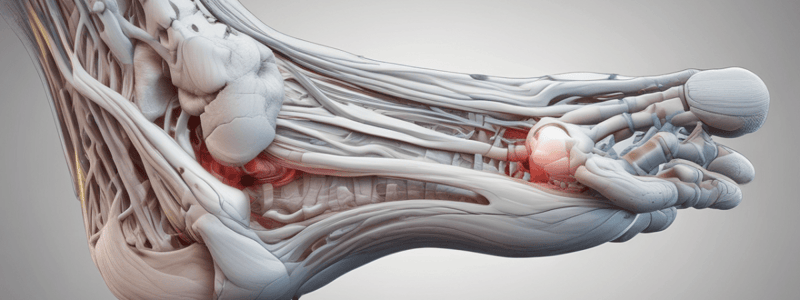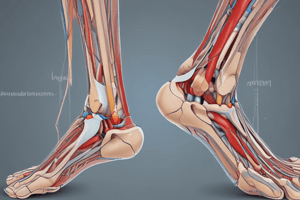Podcast
Questions and Answers
What is the function of the subtalar joint in the foot?
What is the function of the subtalar joint in the foot?
- To stabilize the foot during the swing phase of gait
- To absorb shock during the stance phase of gait (correct)
- To create a rigid lever for push-off during the gait cycle (correct)
- To provide additional support to the plantar arches
Which of the following joints is responsible for adapting to irregularities in the ground?
Which of the following joints is responsible for adapting to irregularities in the ground?
- Subtalar joint (correct)
- Talocrural joint
- Metatarsophalangeal joint
- Mediotarsal joint
What is the primary function of the plantar arches?
What is the primary function of the plantar arches?
- To absorb shock during the stance phase of gait (correct)
- To provide additional support to the ankle joint
- To adapt to irregularities in the ground
- To create a rigid lever for push-off during the gait cycle
Which of the following ligaments provides stability to the subtalar joint?
Which of the following ligaments provides stability to the subtalar joint?
What is the term for the movement of the foot when the talus moves into a closed pack position?
What is the term for the movement of the foot when the talus moves into a closed pack position?
Which of the following bones forms the rearfoot?
Which of the following bones forms the rearfoot?
What is the term for the movement of the foot when the talus moves into a loose pack position?
What is the term for the movement of the foot when the talus moves into a loose pack position?
Which of the following joints is responsible for movements in multiple planes?
Which of the following joints is responsible for movements in multiple planes?
What is the result of pronation on the arch of the foot?
What is the result of pronation on the arch of the foot?
Which facet of the calcaneus follows the concave rule in arthrokinematics?
Which facet of the calcaneus follows the concave rule in arthrokinematics?
What is the function of the talus bone?
What is the function of the talus bone?
What is the primary function of the ankle and foot?
What is the primary function of the ankle and foot?
What is the name of the joint formed by the head of the fibula and the posterolateral aspect of the tibia?
What is the name of the joint formed by the head of the fibula and the posterolateral aspect of the tibia?
Which joint complex is responsible for adapting to the curvature of the plantar arches?
Which joint complex is responsible for adapting to the curvature of the plantar arches?
What is the movement of the proximal tibiofibular joint during dorsiflexion?
What is the movement of the proximal tibiofibular joint during dorsiflexion?
During supination, which movement occurs at the subtalar joint?
During supination, which movement occurs at the subtalar joint?
Which ligament supports the internal arch?
Which ligament supports the internal arch?
What is the shape of the trochlea of the talus?
What is the shape of the trochlea of the talus?
What is the primary function of the distal tibiofibular joint?
What is the primary function of the distal tibiofibular joint?
What is the result of supination on the arch of the foot?
What is the result of supination on the arch of the foot?
What is the type of joint that connects the tibia and fibula?
What is the type of joint that connects the tibia and fibula?
What type of joints are the cuneonavicular, intercuneiform, and tarsometatarsal joints?
What type of joints are the cuneonavicular, intercuneiform, and tarsometatarsal joints?
What is the function of the interosseous membrane in the proximal tibiofibular joint?
What is the function of the interosseous membrane in the proximal tibiofibular joint?
What is the movement of the proximal tibiofibular joint during knee flexion?
What is the movement of the proximal tibiofibular joint during knee flexion?
What is the movement of the concave surface during dorsiflexion in CKC?
What is the movement of the concave surface during dorsiflexion in CKC?
Which ligament provides medial stability to the talocrural joint?
Which ligament provides medial stability to the talocrural joint?
What is the primary muscle responsible for dorsiflexion?
What is the primary muscle responsible for dorsiflexion?
During plantar flexion in OKC, which surface moves with a posterior roll?
During plantar flexion in OKC, which surface moves with a posterior roll?
What structure provides static stability to the talocrural joint?
What structure provides static stability to the talocrural joint?
During dorsiflexion in OKC, which surface moves with an anterior roll?
During dorsiflexion in OKC, which surface moves with an anterior roll?
What is the primary stabilizer of the talocrural joint during plantar flexion?
What is the primary stabilizer of the talocrural joint during plantar flexion?
Which of the following is a dynamic stabilizer of the talocrural joint?
Which of the following is a dynamic stabilizer of the talocrural joint?
What is the degree of freedom of the talocrural joint?
What is the degree of freedom of the talocrural joint?
What is the rest position of the talocrural joint?
What is the rest position of the talocrural joint?
Which of the following statements is true regarding arthrokinematics of the talocrural joint?
Which of the following statements is true regarding arthrokinematics of the talocrural joint?
What is the anatomical composition of the ankle?
What is the anatomical composition of the ankle?
Which of the following bones is NOT part of the midfoot?
Which of the following bones is NOT part of the midfoot?
What is the range of motion of the talocrural joint during dorsiflexion?
What is the range of motion of the talocrural joint during dorsiflexion?
Which of the following statements is true regarding the talocrural joint in a closed kinetic chain?
Which of the following statements is true regarding the talocrural joint in a closed kinetic chain?
What is the compact position of the talocrural joint?
What is the compact position of the talocrural joint?
Flashcards are hidden until you start studying
Study Notes
Biomechanics of the Ankle and Foot
Introduction
- The ankle and foot provide a stable base while conforming to uneven surfaces
- They provide balance and stability while allowing for flexibility to absorb stress and adapt to the ground
- The complex functional and structural interaction is possible between joints, connective tissues, and muscles
Tibiofibular Joints
- The mortise adjusts its position as the talus moves
- Proximal tibiofibular joint (PTFJ): head of fibula with posterolateral aspect of tibia
- Plane joint with anterior and posterior proximal tibiofibular ligaments and interosseous membrane
- Distal tibiofibular joint (DTFJ): concave face (tibia) and convex face (fibula)
- Syndesmosis with anterior and posterior distal tibiofibular ligaments and fibrous fat tissue connecting the tibia and fibula
- Proximal tibiofibular joint (PTFJ): head of fibula with posterolateral aspect of tibia
Arthrokinematics of the Tibiofibular Joints
- A slight gliding motion in the PTFJ is possible during osteokinematics of the ankle and knee:
- Dorsiflexion: cranial glide
- Plantar flexion: caudal glide
- Knee flexion: forward glide
- Knee extension: posterior glide
Anatomy: Ankle & Foot
- Ankle → Talocrural Joint (tibia, fibula, and talus)
- Anatomical perspective: talocrural joint
- Functional Perspective: + proximal and distal tibiofibular joint and interosseous membrane
- Foot → all tarsal bones and joints distal to the ankle
- Rearfoot: talus, calcaneus, and subtalar joint
- Midfoot: navicular, cuboid, 3 cuneiforms
- Forefoot: metatarsals and the phalanges, including all distal joints and tarsometatarsal joints
Talocrural Joint
- Mortise by medial malleolus and lateral malleolus (tibiofibular syndesmosis) – talus
- Hinge joint with 1 degree of freedom
- Rest position: 10° plantar flexion
- Compact position/close pack: maximal dorsiflexion
- Concave/convex rule:
- Open kinetic chain: convex rule
- Closed kinetic chain: concave rule
Osteokinematics of the Talocrural Joint
- Range of motion:
- Dorsiflexion: 0-20/30°
- Plantarflexion: 0-50°
Arthrokinematics of the Talocrural Joint
- Arthrokinematics:
- Slide: anterior (talus) – posterior (mortise)
- Roll: posterior (talus) – anterior (mortise)
- Osteokinematics:
- Plantar flexion (OKC): anterior (talus) – posterior (talus)
- Dorsiflexion (OKC): posterior (talus) – anterior (talus)
- Plantar flexion (CKC): posterior (mortise) – posterior (mortise)
- Dorsiflexion (CKC): anterior (mortise) – anterior (mortise)
Subtalar Joint
- Oblique axis: hence pronation and supination
- Pronation: dorsiflexion, eversion, and abduction (lowering of the arch)
- Supination: plantar flexion, inversion, and adduction (elevation of the arch)
Simplified Arthrokinematics of the Subtalar Joint
- Arthrokinematics:
- Posterior facet of calcaneus: convex rule (OKC)
- Anterior facet of calcaneus: concave rule (OKC)
- Osteokinematics:
- Supination (OKC): medial (calcaneus) – lateral (calcaneus)
- Pronation (OKC): lateral (calcaneus) – medial (calcaneus)
- Supination (CKC): lateral (talus) – medial (talus)
- Pronation (CKC): medial (talus) – lateral (talus)
Midtarsal / Chopart`s Joint
- Talonavicular and calcaneocuboid joints
- Osteokinematics: combined with subtalar joint, also contributes to:
- Pronation
- Supination
- Simplified Arthrokinematics: concave rule (OKC) gliding
Other Tarsal Joints
- Cuneonavicular, intercuneiform, and tarsometatarsal / Lisfrank joint
- Plane joints
- Adapt the curvature of plantar arches
Studying That Suits You
Use AI to generate personalized quizzes and flashcards to suit your learning preferences.




